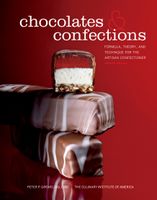Advertisement
By Peter Greweling and Culinary Institute of America
Published 2007
The word nougat is derived from the Latin word nux, meaning “walnut.” There is evidence that, in ancient times, precursors of today’s nougat were made using egg whites, honey, and nuts. Given the derivation of the word, it stands to reason that nougat often contains nuts, but this is no longer its defining quality. Nougat is a foam aerated with egg whites or albumen and containing cooked sugar, glucose syrup, and honey in varying proportions. Nougat may be white and firm, like the venerable classic nougats Montelimar and torrone. Or it may be soft and very light, as in some American candy bars. It may contain chocolate, coffee, or other flavorings. Some nougat formulas intentionally induce crystallization to create a short, tender texture; in other formulas the confection is left uncrystallized to provide chewiness. A wealth of dry inclusions may be used in nougat, among them candied and dried fruit or seeds, but the most ubiquitous inclusions are nuts—usually almonds, pistachios, and hazelnuts. Once finished, nougat may be deposited in a slab, sandwiched between wafer papers, or cut into individual portions or bars and dipped partially or fully in chocolate. Given all of the variables of texture, flavor, inclusions, and finishing techniques, the possible variations are nearly endless.



